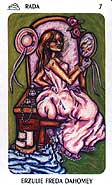Today's Tarot for Beyonce
| The One Card spread is the most concise of all spreads, intended to provide a quick take on a situation, or to reduce it to a single point of meditation. The Voodoo Tarot of New Orleans is a deck rich in primal spirituality. It draws on images from the religion Santeria, which weaves Catholic and African beliefs into a vibrant tapestry. This exceptional deck is most often used to ask questions regarding the joy, fury, and spirituality in everyday life. If you would like your own copy of the Voodoo Tarot of New Orleans, you can buy it now! |
 | The card represents the critical factor for the issue at hand. Erzulie Freda Dahomey (Seven of Swords): An opportunity to withdraw from a hopeless situation and fight another day. Disengagement from a struggle you should never have been involved in. A desperate attempt to resolve a matter without conflict. The use of cleverness or outright deception to turn the tide in your favor. |
|
|




